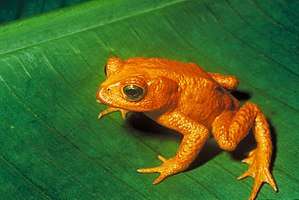Herpetology
Herpetology (from Greek ἑρπετόν herpetón, meaning "reptile" or "creeping animal") is the branch of zoology concerned with the study of amphibians (including frogs, toads, salamanders, newts, and caecilians (gymnophiona)) and reptiles (including snakes, lizards, amphisbaenids, turtles, terrapins, tortoises, crocodilians, and the tuataras). Birds, which are cladistically included within Reptilia, are traditionally excluded here; the scientific study of birds is the subject of ornithology.

Thus, the definition of herpetology can be more precisely stated as the study of ectothermic (cold-blooded) tetrapods. Under this definition "herps" (or sometimes "herptiles" or "herpetofauna") exclude fish, but it is not uncommon for herpetological and ichthyological scientific societies to "team up", publishing joint journals and holding conferences in order to foster the exchange of ideas between the fields, as the American Society of Ichthyologists and Herpetologists does. Many herpetological societies have been formed to promote interest in reptiles and amphibians, both captive and wild.
Herpetology offers benefits to humanity in the study of the role of amphibians and reptiles in global ecology, especially because amphibians are often very sensitive to environmental changes, offering a visible warning to humans that significant changes are taking place. Some toxins and venoms produced by reptiles and amphibians are useful in human medicine. Currently, some snake venom has been used to create anti-coagulants that work to treat strokes and heart attacks.
Etymology
The word herpetology is from Greek: ἑρπετόν, herpetón, "creeping animal" and -λογία, -logia, "knowledge". People with an avid interest in herpetology and who keep different reptiles or amphibians often refer to themselves as "herpers".[1]
"Herp" is a vernacular term for non-avian reptiles and amphibians. It is derived from the old term "herpetile", with roots back to Linnaeus's classification of animals, in which he grouped reptiles and amphibians together in the same class. There are over 6700 species of amphibians[2] and over 9000 species of reptiles.[3] In spite of its modern taxonomic irrelevance, the term has persisted, particularly in the names of herpetology, the scientific study of non-avian reptiles and amphibians, and herpetoculture, the captive care and breeding of reptiles and amphibians.
Subfields
The field of herpetology can be divided into areas dealing with particular taxonomic groups such as frogs (batrachology),[4]:9[5] snakes (ophiology or ophidiology), lizards (saurology) or turtles (cheloniology, chelonology or testudinology).
More generally, herpetologists work on functional problems in ecology, evolution, physiology, behavior etc. of amphibians and reptiles. That is, they chose to use amphibians or reptiles as model organisms for specific questions in these fields, such as the role of frogs in the ecology of a wetland. All of these areas are related through their evolutionary history, e.g. the evolution of viviparity (including behavior and reproduction).[6]
Careers
Career options in the field of herpetology include, but are not limited to lab research, field studies and survey, zoological staff, museum staff and college teaching.
In modern academic science, it is rare for individuals to consider themselves a herpetologist first and foremost. Most individuals focus on a particular field such as ecology, evolution, taxonomy, physiology, or molecular biology, and within that field ask questions pertaining to or best answered by examining reptiles and amphibians. For example, an evolutionary biologist who is also a herpetologist may choose to work on an issue such as the evolution of warning coloration in coral snakes.[7]
Modern herpetological writers include Mark O'Shea and Philip Purser. Modern herpetological showmen include Jeff Corwin, Steve Irwin, popularly known as the "Crocodile Hunter", and the star Austin Stevens, popularly known as "AustinSnakeman" in the TV series Austin Stevens: Snakemaster.
Study
Most colleges or universities do not offer a major in herpetology at the undergraduate or even the graduate level. Instead, persons interested in herpetology select a major in the biological sciences. The knowledge learned about all aspects of the biology of animals is then applied to an individual study of herpetology.
See also
- Herping
- List of herpetologists
- List of herpetology academic journals
- Reptile Database
References
- "herpers — Community Profile". Community.livejournal.com. 2001-06-09. Archived from the original on 2008-10-20. Retrieved 2012-08-13.
- "AmphibiaWeb". AmphibiaWeb. Retrieved 2012-08-13.
- "Species Statistics February 2012". Reptile-database.org. Retrieved 2012-08-13.
- D.C. Wareham (2005). Elsevier's Dictionary of Herpetological and Related Terminology. Elsevier. ISBN 978-0-08-046017-8.
- Francesco M. Angelici (2015). Problematic Wildlife: A Cross-Disciplinary Approach. Springer. pp. 584–585. ISBN 978-3-319-22246-2.
- Blackburn, Daniel G. (December 2006). "SQUAMATE REPTILES AS MODEL ORGANISMS FOR THE EVOLUTION OF VIVIPARITY". Herpetological Monographs. 20 (1): 131–146. doi:10.1655/0733-1347(2007)20[131:SRAMOF]2.0.CO;2. ISSN 0733-1347.
- Rojas, Bibiana; Valkonen, Janne; Nokelainen, Ossi (2015-05-04). "Aposematism". Current Biology. 25 (9): R350–R351. doi:10.1016/j.cub.2015.02.015. ISSN 0960-9822.
Further reading
- Adler, Kraig (1989). Contributions to the History of Herpetology. Society for the Study of Amphibians and Reptiles.
- Eatherley, Dan (2015). Bushmaster: Raymond Ditmars and the Hunt for the World's Largest Viper. New York: Arcade. 320 pp. ISBN 978-1628725117.
- Goin, Coleman J.; Goin, Olive B.; Zug, George R. (1978). Introduction to Herpetology, Third Edition. San Francisco: W. H. Freeman and Company. xi + 378 pp. ISBN 0-7167-0020-4.
External links
| Wikibooks has a book on the topic of: Snakes of Europe |
- Iranian Herpetological Studies Institute (IHSI)
- Field Herpetology Guide
- American Society of Ichthyologists and Herpetologists
- Herpetological Conservation and Biology
- Societas Europaea Herpetologica Distribution Maps for European Reptiles and Amphibians
- Center for North American Herpetology over 500 species of reptiles and amphibians
- European Field Herping Community
- New Zealand Herpetology
- Chicago Herpetological Society
- Biology of the Reptilia is an online copy of the full text of a 22-volume 13,000-page summary of the state of research of reptiles.
- HerpMapper is a database of reptile and amphibian sightings
- Amphibian and Reptile Atlas of Peninsular California, San Diego Natural History Museum
- A Primer on Reptiles and Amphibians